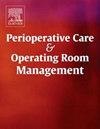更新的成人围手术期低温风险预测模型:系统回顾和荟萃分析
IF 1
Q2 Nursing
Perioperative Care and Operating Room Management
Pub Date : 2025-09-01
DOI:10.1016/j.pcorm.2025.100540
引用次数: 0
摘要
目的系统回顾和批判性评估成人非心脏手术患者意外围手术期低温(IPH)的现有风险预测模型。设计观察性研究的系统回顾和荟萃分析。方法自成立至2023年12月31日进行综合检索。检索的数据库包括PubMed、Web of Science、Medline、Cochrane Library、中国知网(CNKI)、万方数据库、中国科技期刊库(VIP)。两名研究人员按照CHARMS指南独立提取数据,并使用PROBAST检查表进行质量评估。meta分析包括采用外部验证模型的研究,使用MetaDiSc 1.4软件计算效果测量。结果共检索到1792项研究,最终纳入43项研究,包括49个IPH预测模型。逻辑回归是最常用的模型开发方法。以AUC评价模型性能,其范围为0.683 ~ 0.968。常见的预测因素包括年龄、体重指数和环境温度。外部验证模型的meta分析显示,合并AUROC为0.908,具有较强的预测能力。结论IPH预测模型具有良好的应用前景,但其在不同人群中的适用性有待进一步研究。高偏倚风险凸显了方法严谨性的必要性。尽管如此,荟萃分析证实了这些模型在预测围手术期低温方面的稳健性。实施稳健的IPH预测模型可以帮助医疗保健专业人员识别高危患者,从而改善围手术期温度管理和患者预后。试验和方案注册该综述在PROSPERO注册(ID: CRD42023343403)。本文章由计算机程序翻译,如有差异,请以英文原文为准。
Updated risk prediction model for perioperative hypothermia in adults: A systematic review and meta-analysis
Aim
To systematically review and critically assess existing risk prediction models for inadvertent perioperative hypothermia (IPH) in adult patients undergoing non-cardiac surgery.
Design
Systematic review and meta-analysis of observational studies.
Methods
A comprehensive search was conducted from inception to December 31, 2023. The databases searched included PubMed, Web of Science, Medline, the Cochrane Library, China National Knowledge Infrastructure (CNKI), Wanfang Database, and China Science and Technology Journal Database (VIP). Two researchers independently extracted data following CHARMS guidelines, and quality assessment was performed using the PROBAST checklist. Meta-analysis included studies with externally validated models, with effect measures calculated using MetaDiSc 1.4 software.
Results
A total of 1792 studies were retrieved, with 43 studies comprising 49 IPH prediction models included in the final review. Logistic regression was the most common method for model development. Model performance, assessed by AUC, ranged from 0.683 to 0.968. Frequent predictors included age, BMI, and ambient temperature. The meta-analysis of externally validated models showed a pooled AUROC of 0.908, demonstrating strong predictive capability.
Conclusion
Despite the promising performance of the IPH prediction models, their applicability to diverse populations needs further consideration. High risk of bias highlights the need for methodological rigor. Nonetheless, meta-analysis confirms the robustness of these models in predicting perioperative hypothermia.
Implications
Implementing robust IPH prediction models can aid healthcare professionals in identifying high-risk patients, thus improving perioperative temperature management and patient outcomes.
Trial and Protocol Registration
The review was registered in PROSPERO (ID: CRD42023343403).
求助全文
通过发布文献求助,成功后即可免费获取论文全文。
去求助
来源期刊

Perioperative Care and Operating Room Management
Nursing-Medical and Surgical Nursing
CiteScore
1.30
自引率
0.00%
发文量
52
审稿时长
56 days
期刊介绍:
The objective of this new online journal is to serve as a multidisciplinary, peer-reviewed source of information related to the administrative, economic, operational, safety, and quality aspects of the ambulatory and in-patient operating room and interventional procedural processes. The journal will provide high-quality information and research findings on operational and system-based approaches to ensure safe, coordinated, and high-value periprocedural care. With the current focus on value in health care it is essential that there is a venue for researchers to publish articles on quality improvement process initiatives, process flow modeling, information management, efficient design, cost improvement, use of novel technologies, and management.
 求助内容:
求助内容: 应助结果提醒方式:
应助结果提醒方式:


